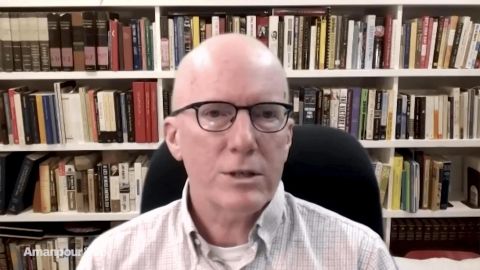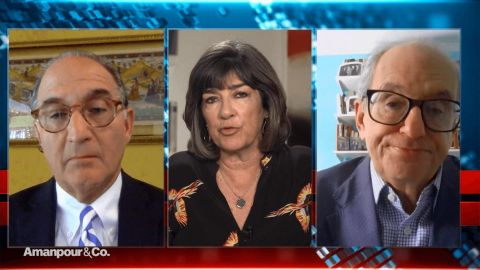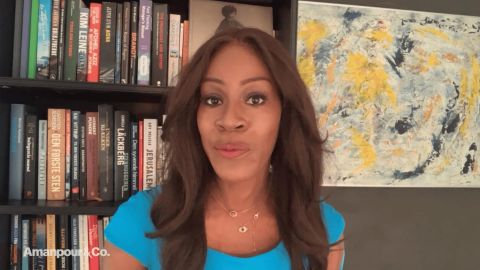Read Transcript EXPAND
CHRISTIANE AMANPOUR: With the presidential election fast approaching, many states are expanding postal voting in an effort to keep people safe amid the coronavirus pandemic. But problems with recent primaries are ringing alarm bells. Charles Stewart is a professor of political science and the director of the MIT Election Data and Science Lab. And here he is speaking with our Hari Sreenivasan about why this has become so politically charged and how officials need to prepare for November.
HARI SREENIVASAN: Thanks, Christiane. Charles, thanks for joining us. There’s been a lot of talk in the last few weeks about the importance of giving people access to vote by mail, considering that we’re heading into an election in the middle of the pandemic, that voting from home would be better for your health, right? I want to talk a little bit about your concerns about why we should not rely too heavily on this as our one-size-fits-all solution.
CHARLES STEWART, DIRECTOR, MIT ELECTION DATA AND SCIENCE LAB: There’s many reasons we want to retain robust in-person voting sites. An important reason is that a number of people just need to vote in person. They could be people with disabilities. They could be people who don’t — have made mistakes with the mail ballot system. We have seen a number of cases during the primaries where ballots arrive late, et cetera. There are people who don’t trust the Postal Service. And then, finally, we just know a lot about voter behavior. And we know that the people who vote in November, particularly the ones voting in November who didn’t vote in the primaries, are going to be, by and large, low-propensity voters, people who are not as attuned to politics as probably the people watching this show are. And they’re going to decide at the last minute to vote, and they’re going to need a place to go to vote. And when those people flood into polling places, we want to make sure that there aren’t undue long lines out in the streets waiting to get in. And we want to be able to move people through these enclosed polling places as quickly as we can. So, we need a lot of — we need in-person polling places, and we need a lot of them.
SREENIVASAN: If you were to design a system today, what would that mix be, given the circumstances that we’re in? If you’re advising an election official, what do you tell them to plan for, how many people show up in person vs. how many people — they might have a surge in mail-in ballots above normal, but what should they be prepared for in November?
STEWART: Well, I mean, the advice is going to be very specific, of course, to the jurisdiction and to the state. But, generally speaking, right now, I think we have to, first of all, take into account that we really don’t know for sure, and that we have to build in a lot of resilience on both sides. And so I have been jokingly saying that, most places, plan for 70 percent of your voters to turn out in mail and plan for 70 percent to turn out in person. And we will see what the pandemic is like. We will see what President Trump is tweeting. We will see a wide variety of other things in November. But plan for all contingencies.
SREENIVASAN: Since we have seen the lines in Wisconsin, and since the country has been grappling with this pandemic, which more of the country is waking up to the fact that we are not dealing with it as well as we could or should, what does that do to voter confidence?
STEWART: One of the things that’s really struck me during the primary season is that voters have actually risked their health to go vote. Turnout in the Democratic primary in 2020 is on a par, in fact, up compared to what the turnout was in 2016. It’s been down on the Republican side, but it’s not contested on that side. But, on the Democratic side, it’s been up a little bit. So, voters are going to the polls. They’re mailing in their ballots, but they’re also going in on Election Day. And so I think that voters these days are intent the vote. They’re going to vote on. And everything else about this election season tells me we should actually expect for record turnout, even if there’s a spike around Election Day, because of — the attitudes and anxieties are just so high on both sides.
SREENIVASAN: What are the fail rates associated with ballots that are mailed in?
STEWART: Well, there’s a number of ways of measuring that. In 2016, roughly 1 percent of ballots ended up being rejected, for instance, mail ballots ended up being rejected. And so that’s a starting point. But I think we also have to remember that different states are more likely to closely scrutinize ballots and be unforgiving of mistakes. In the vote-by-mail states like Washington, Oregon, Colorado, their rejection rate in 2016 was closer to nine-tenths of 1 percent. But, in some states that make it really hard — New York has been a good example in the news the last few weeks. It can range that from 3 to 5 percent of rejection rates. And so that’s one of the things I’m concerned about this November, is that some of the states that are seeing big surges in vote by mail also have traditions of rejecting a lot of mail ballots, usually for highly technical reasons that are obscure to voters. And the voters are kind of surprised when they see that their ballot has been rejected.
SREENIVASAN: The president of the United States for several weeks now has been making the case that mail-in ballots will contribute to the most corrupt results, the most corrupt process, unless changed by the courts, will lead to the most corrupt election in our nation’s history. When you hear statements like that, is it justified by any fact?
STEWART: No, it’s not. nd when I hear statements like that from President Trump, from Attorney General Barr, I mean, the first thing an expert like me thinks is that they just don’t know what they’re talking about, because President Trump, for instance, is distinguishing between voting by mail, on one hand, and absentee voting, on the other hand, which he has done, claiming that it’s the vote-by-mail states where there’s been massive fraud. Well, again, Oregon, Washington, Colorado, they take this really seriously because it’s their entire voting system. And there is no evidence at all in those states that there’s been massive fraud in the elections over the last decade or two in which they have been doing vote by mail. So it’s just not true. I mean, there is fraud sometimes. And voting by mail does have certain opportunities for it. But there are more failsafes in voting by mail or voting absentee. And keep in mind there’s more of a paper trail when you vote by mail than when you vote in-person. And so it’s easier to count — to catch people who are trying to do something that’s not right when they’re voting by mail.
SREENIVASAN: What can election officials do to inspire confidence in the process? There was a recent ABC poll out that said almost half of Americans think that voting by mail can be manipulated, is fraudulent, that it’s susceptible to fraud.
STEWART: Right.
SREENIVASAN: That’s not just people who listen to the president. That’s got to include others as well. But underlying that is that, what do you do to make sure people feel that their vote is going to be securely counted?
STEWART: Right. A lot of the opinions that voters have about these matters, about whether an election is legitimate, et cetera, is actually driven by what they’re hearing from partisan leadership. And so it really does matter what President Trump says. It matters what Joe Biden says and other party leaders. And so there’s limits to what can be done if you’re just worried about public opinion. But there are things that officials can do. And I think that the most important thing that they can do is to be transparent about the process, to invite people to observe what’s going on. That’s the best practice, and it’s common around the country. To have no ballot counting rooms open to observers, put a Webcam in that room, so that it’s not just the party officials who are observing, but any citizen can watch the envelopes being open, and watch them being counted, can watch the machines be calibrated and certified. And I think that that — being transparent about the process is probably the most important thing that election officials can do to satisfy those who will take evidence as their guide for whether they can trust the system or not. And then — and then I hope — I hope people like us will then be — we will take that evidence in and judge for ourselves.
SREENIVASAN: How much actual election fraud is there? I mean, after the election of President Trump, he set up a commission for a while to study this. I don’t know if there were final results of that. But, historically, what’s been the case? What is it at now?
STEWART: Well, that commission, President Trump’s commission, disbanded without making a report. Historically, back in the 19th — late 19th century, where I think we gain a lot of our kind of casual beliefs about fraud, there was a lot of fraud, there was a lot of coercion, there was a lot of double voting, et cetera. And a lot of the protections that we use in elections now come out of the late 19th century. But I would say that, by and large, since the mid 20th-century, with some exceptions from time to time, elections have been pretty, pretty clean in most places. Very recently, there have been efforts to gather up and measure all of the prosecutions, for instance, for voter fraud around the country. And when you add up all those prosecutions for voter fraud, say, over the last couple of decades, and you then divide by the total number of votes that have been cast, in those couple of decades, you will discover the order of magnitude for fraud is something like a ballot per 100,000 or so. can’t give that number on — off the top of my head, but it’s a very small number. And when there is fraud, it gains a lot of attention. You get a lot of attention for it. The final thing I would say about fraud is that the cases that we observe tend to be retail fraud, and especially in the — on voting by mail. Think about this way. Because of the paper trail that goes along with voting by mail, you know, it’s really hard to try to basically organize hundreds of people to all forge the same signature and do those sorts of things. It’s not easy to do. And so the types of fraud we do see in voting by mail is onesies and twosies. It’s things like, widow Jones, papa Jones just died, and she knows that he really wanted to support Donald Trump in his dying day, and so she will send in his ballot for him, stuff like that. And it’s oftentimes sad stories. But that’s much, much, much, much more common than nefarious, I mean, truly nefarious attempts to try to corrupt the system through any sort of voter fraud, whether it be by mail or in- person.
SREENIVASAN: Let’s fast-forward to election night. One of the things that you almost warn for is that we the press and really the country should be open to a scenario where there is not a winner that night.
STEWART: We need to be prepared for what some people have called election week, rather than Election Day. The reason for that is that many of these local jurisdictions are going to be unable to automate the counting of their ballots. In some states like Michigan, the state legislature is prohibiting election officials from even processing the mail ballots until the polls close. And so there are things out there that will just cause the count to be longer than it’s ever been before. And we just need to be prepared for that. And, again, election officials need to be transparent about what’s going on during that count. But we need to be prepared for that.
SREENIVASAN: During Chris Wallace’s interview with the president recently, the president was asked if he would accept the election results. And he said: “I have to see. No, I’m not going to say yes. I’m not going to say no.” What did you think when you heard that news?
STEWART: Well, I went actually wasn’t surprised, because that’s what he said four years ago. And he’s not become a bigger — a bigger friend of election administration since then. And so I think that’s unfortunate. I mean, there’s a way of answering a question like that in which you maybe can acknowledge that there could be disputes in the election and that one wants to fight for every vote you’re legally entitled to. I understand that point. But you can say, well, of course, after the counting is done, and the votes have been certified, I will accept that I have lost, if, in fact, on that’s what the votes say. So, there’s a way of answering that question that doesn’t give away the right to dispute legitimately what’s going on, and so, yes, very unfortunate.
SREENIVASAN: Are election officials ready? And if they’re not ready, what can they do between now and Election Day?
STEWART: The — I would say the issue is not so much, are they getting ready, but have the state legislatures and the (AUDIO GAP) created the conditions under which they can act efficiently? For instance, has the state legislature changed the laws so that you can start count — or you can at least start processing mail ballots on Election Day, rather than waiting for the polls to close, little things like that I think in some states haven’t been done and may not be done? Some local officials may not be able to buy the automation equipment to facilitate the easy mailing out and the processing of all the paper that comes back. That cost is going to be paid in time at the back end, as processes and things are done manually. So, my sense is that, by and large, election officials have gotten the word, gotten beaten up, know what they have to do, are being pushed to do what they need to do. And — but I wouldn’t trust me. I would pay attention to what’s happening in someone’s state and locality and make sure that that’s actually what’s happening.
SREENIVASAN: In addition to that, what keeps you up at night?
STEWART: Oh, in some ways, that’s enough, right? I — there’s a couple of things that worry me. One of the things that worries me right now is just being unable to recruit enough poll workers to meet the in-person demand. There’s been a lot of emphasis on voting by mail, and I think appropriately so. But it may have distracted a number of people from the importance of voting in person. And so that’s something that really does worry me. But the second thing is this concern about the post-Election Day period going off the rails because of just loose talk about fraud during the counting. This is — our democracy is too important just to be throwing around unfounded charges of fraud. And that’s really the thing that keeps me up at night and makes me realize that I think we’re going to have to hunker down for at least two weeks after Election Day and be in constant battle mode, because I think the campaigns, particularly Donald Trump — I don’t want to be accused of two-sider-ism here — I think we have seen it more from the Trump side — will keep pushing and pushing and pushing as far and as hard as they can.
SREENIVASAN: All right, Charles Stewart, the professor of political science at MIT and part of the MIT-Stanford Healthy Election Project, thanks so much for joining us.
STEWART: My pleasure. Thank you.
About This Episode EXPAND
Steve Leifman and Norm Ornstein discuss mental illness and the prison industrial complex. Director Amma Asante discusses Hulu’s new mini series “Mrs. America.” Charles Stewart, director of MIT’s Election Data and Science Lab, discusses voting by mail and why election officials need to prepare now for November.
LEARN MORE


